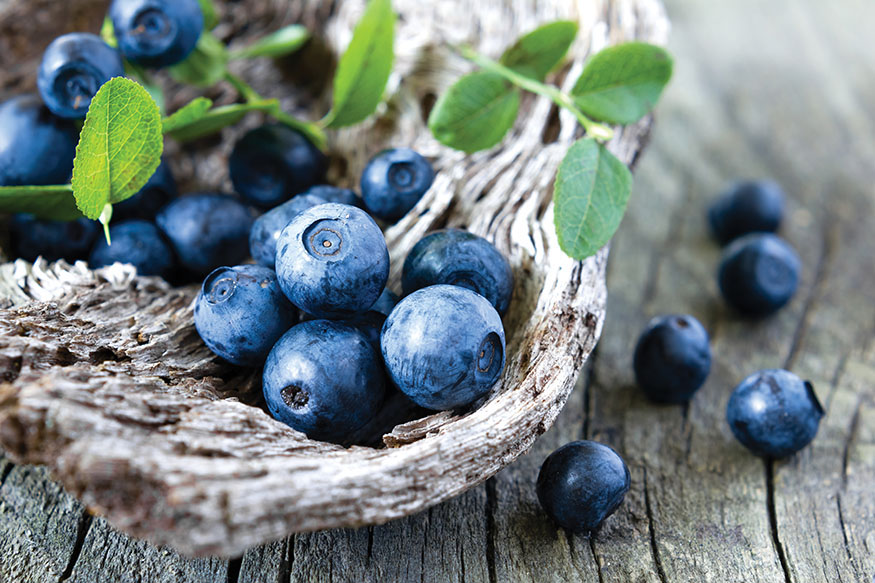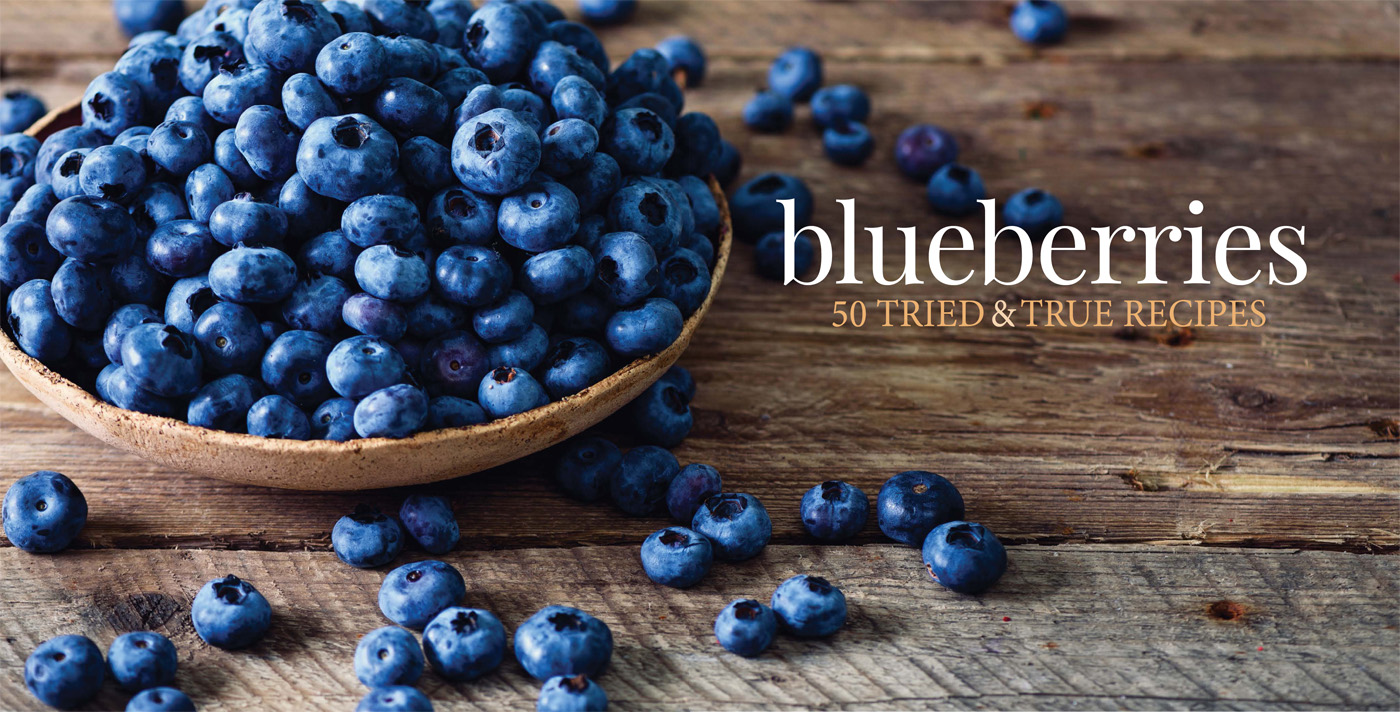

 Cover and book design by Lora Westberg Edited by Emily Beaumont All images copyrighted. Cover images: All images by Julia Rutland unless otherwise noted. Africa Studio/shutterstock.com: cone, back cover; baibaz/shutterstock.com: jam; Prolightstudio/shutterstock.com: background; Yellow Cat shutterstock.com: cookie All images by Julia Rutland unless otherwise noted. Used under license from Shutterstock.com: Sunny Forest: 2-3; HandmadePictures: 17; J.chizhe: 4-5; valzan: 9 10 9 8 7 6 5 4 3 2 1 blueberries: 50 Tried & True Recipes Copyright 2019 by Julia Rutland Published by Adventure Publications An imprint of AdventureKEEN 330 Garfield Street South Cambridge, Minnesota 55008 (800) 678-7006 www.adventurepublications.net All rights reserved Printed in China ISBN 978-1-59193-847-7 (pbk.); ISBN 978-1-59193-848-4 (ebook)
Cover and book design by Lora Westberg Edited by Emily Beaumont All images copyrighted. Cover images: All images by Julia Rutland unless otherwise noted. Africa Studio/shutterstock.com: cone, back cover; baibaz/shutterstock.com: jam; Prolightstudio/shutterstock.com: background; Yellow Cat shutterstock.com: cookie All images by Julia Rutland unless otherwise noted. Used under license from Shutterstock.com: Sunny Forest: 2-3; HandmadePictures: 17; J.chizhe: 4-5; valzan: 9 10 9 8 7 6 5 4 3 2 1 blueberries: 50 Tried & True Recipes Copyright 2019 by Julia Rutland Published by Adventure Publications An imprint of AdventureKEEN 330 Garfield Street South Cambridge, Minnesota 55008 (800) 678-7006 www.adventurepublications.net All rights reserved Printed in China ISBN 978-1-59193-847-7 (pbk.); ISBN 978-1-59193-848-4 (ebook)  Acknowledgments A bushel of thanks to my dear family: Dit, Emily, and Corinne, who give me the patient support to handle any project, even if it means foraging for dinner when the only hot things on the table are pies, cookies, and turnovers. To my dear friends Susan Dosier and Jackie Millsthanks for being my sounding board and text-based support group! You are hundreds of miles away and yet always near and dear. And to my friend Lynne Weems Ryan: Thank you for your delicious contributions and constant generosity.
Acknowledgments A bushel of thanks to my dear family: Dit, Emily, and Corinne, who give me the patient support to handle any project, even if it means foraging for dinner when the only hot things on the table are pies, cookies, and turnovers. To my dear friends Susan Dosier and Jackie Millsthanks for being my sounding board and text-based support group! You are hundreds of miles away and yet always near and dear. And to my friend Lynne Weems Ryan: Thank you for your delicious contributions and constant generosity.
Thanks to the eager and willing taste-testers of the Ashby Farm Circle Book Club: Paige, Vicki, Sharon (especially for those extra homegrown berries!), Barbara, Connie, Lee, Karen, Jillian, and Rhonda. To Brett, Emily, and Lora of AdventureKEEN: A big shout-out for helping me create this delightful project that you patiently fine-tuned.  About Blueberries Wild First Its estimated that wild blueberry plants appeared in Maine more than 10,000 years ago when glaciers receded, and the first scrubby plants grew out of the stressed landscape. Native Americans harvested the berries, followed by European settlers, and yet the crop remained a local bounty. This changed during the Civil War when the berries were harvested, canned, and shipped to feed the Union Army. Hybrids Arrive Skip ahead to 1911, when a farmers daughter named Elizabeth White teamed up with botanist Frederick Coville to crossbreed and hybridize blueberries that would be suitable as a domesticated, commercial crop.
About Blueberries Wild First Its estimated that wild blueberry plants appeared in Maine more than 10,000 years ago when glaciers receded, and the first scrubby plants grew out of the stressed landscape. Native Americans harvested the berries, followed by European settlers, and yet the crop remained a local bounty. This changed during the Civil War when the berries were harvested, canned, and shipped to feed the Union Army. Hybrids Arrive Skip ahead to 1911, when a farmers daughter named Elizabeth White teamed up with botanist Frederick Coville to crossbreed and hybridize blueberries that would be suitable as a domesticated, commercial crop.
In 1916, their first commercial crop of highbush blueberries was sold out of Whitesbog, New Jersey. Worldwide Success Commercial blueberry acreage continues to increase, with about half the worlds supply coming from the United States. Blueberries are grown commercially in 38 states, but 98 percent of the supply comes from just 10 states: California, Florida, Georgia, Indiana, Michigan, Mississippi, New Jersey, North Carolina, Oregon, and Washington. Maine provides the bulk of the nations wild blueberry crop. Planting and Growing Blueberries With a small bit of effort, blueberry plants will produce berries for decades. Somewhat easy to grow, blueberry bushes can be used as an ornamental landscape shrub in your yard while supplying sweet white flowers, blue fruit, and then colorful red leaves in the fall.
While blueberries are native to North America, particular varieties are more suited to one region or another. Of the main species of blueberries, there are four main groups: lowbush, Northern highbush, Southern highbush, and rabbiteye. Lowbush blueberries (Vaccinium angustifolium) are also called wild blueberries, although they are often a carefully managed fruit crop. These native plants are named for their obvious short stature (topping out at less than 2 feet tall), and they can be used as ground cover. They produce small, intensely flavored berries in early summer. Lowbush blueberries thrive in cold climates, in hardiness zones 26.
Because the plant remains smallish, lowbush blueberries can be grown in containers. Although cold hardy when planted in the ground, potted plants need to be brought under cover during cold spells so the roots dont freeze. Lowbush blueberries spread by seed or underground rhizomes, but limited cultivars are available for purchase. Northern highbush (Vaccinium corymbosum) is the most common blueberry variety grown around the world. Most of the berries in grocery stores are from highbush plants. More than half of the highbush blueberries grown are sold fresh in markets; the rest are frozen, canned, or dried.
As the name implies, highbush plants can reach heights of 10 to 12 feet. Heat tolerant to zone 7, highbush blueberries require sufficient cold to produce flowers and fruit, so the plants are not suitable for Southern gardens with warm to mild winters. When new varieties are introduced, theyre classified by early-, mid-, or late-season. Southern highbush (Vaccinium corymbosum hybrid) blueberries were created to bring blueberry production to the South, in climates with hot, humid summers and mild winters. These vigorous plants grow 6 to 8 feet tall and are rated for zones 710. Rabbiteye (Vaccinium ashei or Vaccinium virgatum) blueberries get their name from the way they turn pink before they turn blue, a shade resembling rabbits eyes.
Recommended for hardiness zones 710, rabbiteye blueberries are the most heat tolerant and least cold tolerant, making this a popular plant for its native, warm southeastern climate. With a vigorous growth habit, these plants can reach up to 20 feet tall if left unpruned (not recommended, unless you are keen to feeding the birds). Rabbiteyes taste sweeter than Northern highbush varieties, but their skins can get tough when frozen. Half-High , a hybrid cross between Northern highbush and lowbush plants, this type tolerates cold temperatures. These small (3- to 4-feet-high) plants do well in containers. Gardening How-Tos Purchase at least two different types in the same group (based on climate), and more is better.
While most blueberry plants are self-fertile, meaning you dont need another plant to produce berries, cross-pollination with other varieties increases the chance of getting larger berries. If planting several bushes, select some with different fruiting schedules (labeled early-, mid-, or late-season) for a longer harvest time. Select a sunny location. While blueberries are somewhat shade tolerant, they will produce more berries when grown in the sun. Space plants out based on how large they will become when mature. Plant lowbush 2 feet apart, highbush 5 to 8 feet apart, and rabbiteyes 10 to 15 feet apart.
Blueberries thrive in acidic, moist, and well-aerated soil. For best results, gardeners should test the pH of the soil and correct to a range of 4.5 to 5.5 with sulfur and other additives. Small, pale leaves and poor growth indicate a pH that is too high (alkaline). Other acid-loving plants include azaleas, rhododendrons, blue hydrangeas, and dogwoods. If those are growing well, then your soil is close to perfect. Dig a hole about twice as wide and twice as deep as the roots, filling in with soil amendments such as peat moss, composted leaves, or pine needles.
Blueberries are shallow rooted, so make sure not to plant the bush any deeper than it was in the pot. Dont fertilize immediately; wait several weeks before administering a light dose. Newly planted blueberries wont need pruning for a few years. Later, prune crowded branches to encourage new branching. (New branches wont produce berries the first year, so dont prune all the plants, or just prune portions of the plants.) Lowbush blueberries should be pruned hard to the ground when production decreases. The traditional method is to burn off fields, which also serves to reduce insects and diseases.
Next page











 Cover and book design by Lora Westberg Edited by Emily Beaumont All images copyrighted. Cover images: All images by Julia Rutland unless otherwise noted. Africa Studio/shutterstock.com: cone, back cover; baibaz/shutterstock.com: jam; Prolightstudio/shutterstock.com: background; Yellow Cat shutterstock.com: cookie All images by Julia Rutland unless otherwise noted. Used under license from Shutterstock.com: Sunny Forest: 2-3; HandmadePictures: 17; J.chizhe: 4-5; valzan: 9 10 9 8 7 6 5 4 3 2 1 blueberries: 50 Tried & True Recipes Copyright 2019 by Julia Rutland Published by Adventure Publications An imprint of AdventureKEEN 330 Garfield Street South Cambridge, Minnesota 55008 (800) 678-7006 www.adventurepublications.net All rights reserved Printed in China ISBN 978-1-59193-847-7 (pbk.); ISBN 978-1-59193-848-4 (ebook)
Cover and book design by Lora Westberg Edited by Emily Beaumont All images copyrighted. Cover images: All images by Julia Rutland unless otherwise noted. Africa Studio/shutterstock.com: cone, back cover; baibaz/shutterstock.com: jam; Prolightstudio/shutterstock.com: background; Yellow Cat shutterstock.com: cookie All images by Julia Rutland unless otherwise noted. Used under license from Shutterstock.com: Sunny Forest: 2-3; HandmadePictures: 17; J.chizhe: 4-5; valzan: 9 10 9 8 7 6 5 4 3 2 1 blueberries: 50 Tried & True Recipes Copyright 2019 by Julia Rutland Published by Adventure Publications An imprint of AdventureKEEN 330 Garfield Street South Cambridge, Minnesota 55008 (800) 678-7006 www.adventurepublications.net All rights reserved Printed in China ISBN 978-1-59193-847-7 (pbk.); ISBN 978-1-59193-848-4 (ebook)  Acknowledgments A bushel of thanks to my dear family: Dit, Emily, and Corinne, who give me the patient support to handle any project, even if it means foraging for dinner when the only hot things on the table are pies, cookies, and turnovers. To my dear friends Susan Dosier and Jackie Millsthanks for being my sounding board and text-based support group! You are hundreds of miles away and yet always near and dear. And to my friend Lynne Weems Ryan: Thank you for your delicious contributions and constant generosity.
Acknowledgments A bushel of thanks to my dear family: Dit, Emily, and Corinne, who give me the patient support to handle any project, even if it means foraging for dinner when the only hot things on the table are pies, cookies, and turnovers. To my dear friends Susan Dosier and Jackie Millsthanks for being my sounding board and text-based support group! You are hundreds of miles away and yet always near and dear. And to my friend Lynne Weems Ryan: Thank you for your delicious contributions and constant generosity. About Blueberries Wild First Its estimated that wild blueberry plants appeared in Maine more than 10,000 years ago when glaciers receded, and the first scrubby plants grew out of the stressed landscape. Native Americans harvested the berries, followed by European settlers, and yet the crop remained a local bounty. This changed during the Civil War when the berries were harvested, canned, and shipped to feed the Union Army. Hybrids Arrive Skip ahead to 1911, when a farmers daughter named Elizabeth White teamed up with botanist Frederick Coville to crossbreed and hybridize blueberries that would be suitable as a domesticated, commercial crop.
About Blueberries Wild First Its estimated that wild blueberry plants appeared in Maine more than 10,000 years ago when glaciers receded, and the first scrubby plants grew out of the stressed landscape. Native Americans harvested the berries, followed by European settlers, and yet the crop remained a local bounty. This changed during the Civil War when the berries were harvested, canned, and shipped to feed the Union Army. Hybrids Arrive Skip ahead to 1911, when a farmers daughter named Elizabeth White teamed up with botanist Frederick Coville to crossbreed and hybridize blueberries that would be suitable as a domesticated, commercial crop.